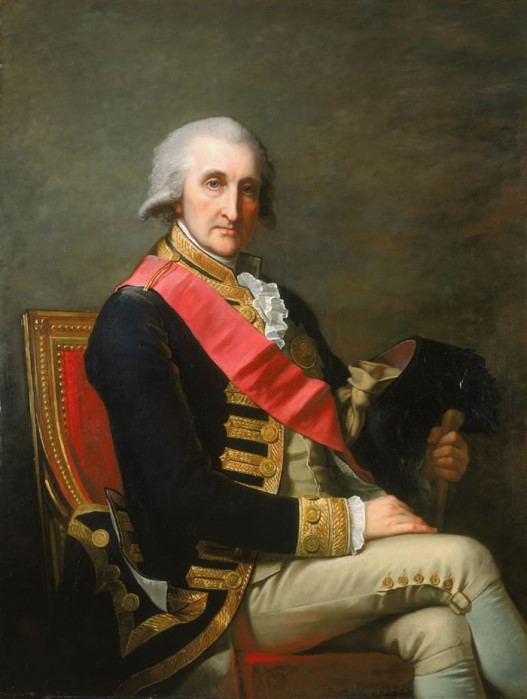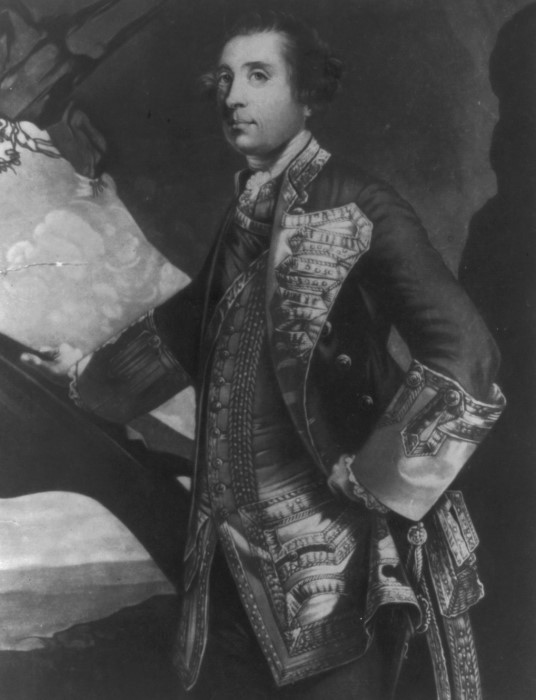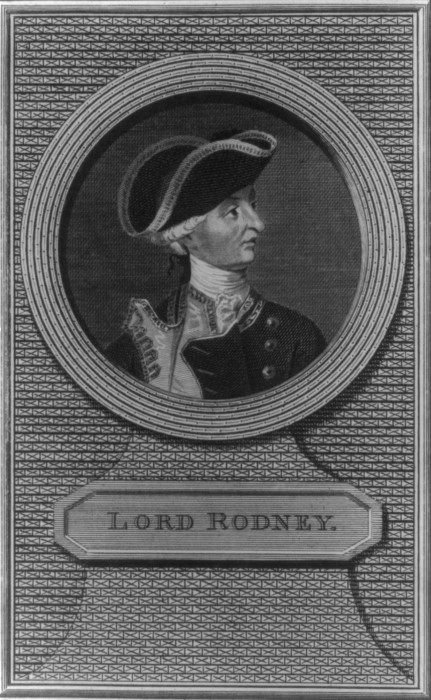Admiral Sir
George Brydges Rodney, 1st Baron Rodney, K.B. |
|
(1719-1792) |
 |
1791 Portrait of Admiral Sir George Brydges Rodney, 1st Baron Rodney KB, RN by Jean-Laurent Mosnier.
|
 |
Portrait of Sir George Brydges Rodney, artist unknown.
|
 |
1785 Portrait of Admiral Sir George Brydges Rodney, 1st Baron Rodney KB, RN by John Fielding.
|
Admiral George Brydges Rodney was born February 13, 1719 in Walton-on-Thames, though the family seat was Rodney Stoke, Somerset. His father had served in Spain under the Earl of Peterborough, and on quitting the army served as captain in a marine corps which was disbanded in 1713. George was sent to Harrow, being appointed, on leaving, by warrant dated June 21, 1732, a volunteer on board Sunderland. While serving on the Mediterranean station he was made lieutenant in Dolphin, his promotion dating February 15, 1739. In 1742, he attained the rank of post-captain, having been appointed to the Plymouth on November 9. After serving in home waters, he obtained command of the battleship Eagle 60, and in this ship took part in Hawke's victory off Ushant (October 14, 1747) over the French fleet. On that day Rodney gained his first laurels for gallantry, under a chief to whom he was in a measure indebted for subsequent success. On May 9, 1749 he was appointed governor and commander-in-chief of Newfoundland, with the rank of Commodore, it being usual at that time to appoint a naval officer, chiefly on account of the fishery interests. He was elected M.P. for Saltash in 1751, and married his first wife, Jane Compton (1730-1757), sister of Charles Compton, 7th Earl of Northampton, in 1753. During the Seven Years' War Rodney rendered important services. In 1757, he had a share in the expedition against Rochefort, commanding the battleship Dublin 74. Next year, in the same ship, he served under Boscawen at the taking of Louisburg ( Cape Breton Island ). On May 19, 1759 he became a rear-admiral, and was shortly after given command of a small squadron intended to destroy a large number of flat-bottomed boats and stores which were being collected at Havre for an invasion of the English coasts. He bombarded the town for two days and nights, and inflicted great loss of war-material on the enemy. In July 1760, with another small squadron, he succeeded in taking many more of the enemy's flat-bottomed boats and in blockading the coast as far as Dieppe. Elected M.P. for Penryn in 1761, he was in October of that year appointed commander-in-chief of the Leeward Islands station, and within the first three months of 1762 had reduced the important island of Martinique, while both St Lucia and Grenada had surrendered to his squadron. During the siege of Fort Royal (later Fort de France) his seamen and marines rendered splendid service on shore. At the peace of 1763, Admiral Rodney returned home, having been during his absence made Vice-Admiral of the Blue and having received the thanks of both houses of parliament. In 1764, Rodney was created a baronet, and the same year he married Henrietta, daughter of John Clies of Lisbon. From 1765 to 1770, he was governor of Greenwich Hospital, and on the dissolution of parliament in 1768 he successfully contested Northampton at a ruinous cost. When appointed Commander-in-Chief of the Jamaica station in 1771, he lost his Greenwich post, but a few months later received the office of Rear-Admiral of Great Britain. Until 1774, he held the Jamaica command, and during a period of quiet, was active in improving the naval yards on his station. Sir George struck his flag with a feeling of disappointment at not obtaining the governorship of Jamaica, and was shortly after forced to settle in Paris. Election expenses and losses at play in fashionable circles had shattered his fortune, and he could not secure payment of the salary as Rear-Admiral of Great Britain. In February 1778, having just been promoted Admiral of the White, he used every possible exertion to obtain a command, to free himself from his money difficulties. By May, he had, through the splendid generosity of his Parisian friend Marshal Biron, effected the latter task, and accordingly he returned to London with his children. The debt was repaid out of the arrears due to him on his return. The story that he was offered a French command is fiction. Sir George was appointed once more commander-in-chief of the Leeward Islands late in 1779. His orders were to relieve Gibraltar on his way to the West Indies. He captured a Spanish convoy off Cape Finisterre on January 8, 1780, and eight days later at the Battle of Cape St. Vincent defeated the Spanish Admiral Don Juan de Lángara off Cape St. Vincent, taking or destroying seven ships. On April 17 an action, which, owing to the carelessness of some of Rodney's captains, was indecisive, was fought off Martinique with the French Admiral Guichen. Rodney, acting under orders, captured the valuable Dutch island of St Eustatius on February 3, 1781. It had been a great entrepôt of neutral trade, and was full of booty, which Rodney confiscated. As large quantities belonged to English merchants, he was entangled in a series of costly lawsuits. After a few months in England, restoring his health and defending himself in Parliament, Sir George returned to his command in February 1782, and a running engagement with the French fleet on April 9 led up to his crowning victory at the Battle of the Saintes off Dominica, when on April 12 with thirty-five ships of the line he defeated the Comte de Grasse, who had thirty-three sail. The French inferiority in numbers was more than counterbalanced by the greater size and superior sailing qualities of their ships, yet five were taken and one sunk, after eleven hours' fighting. This important battle saved Jamaica and ruined French naval prestige, while it enabled Rodney to write: "Within two little years I have taken two Spanish, one French and one Dutch admirals." A long and wearisome controversy exists as to the originator of the maneuver of "breaking the line" in this battle, but the merits of the victory have never seriously been affected by any difference of opinion on the question. A shift of wind broke the French line of battle, and advantage was taken of this by the English ships in two places. Rodney arrived home in August to receive unbounded honour from his country. He had already been created Baron Rodney of Rodney Stoke, Somerset, by patent of June 19, 1782, and the House of Commons had voted him a pension of £2000 a year. From this time he led a quiet country life till his death in London. He was succeeded as 2nd Baron by his son, George (1753-1802), from whom the present baron is descended. At least four serving warships of the Royal Navy have been named HMS Rodney in his honour. One of the five houses of British public school Church 's College is named for him. |
(Text courtesy of Wikipedia)
|
Page published Mar. 13, 2008 |
||